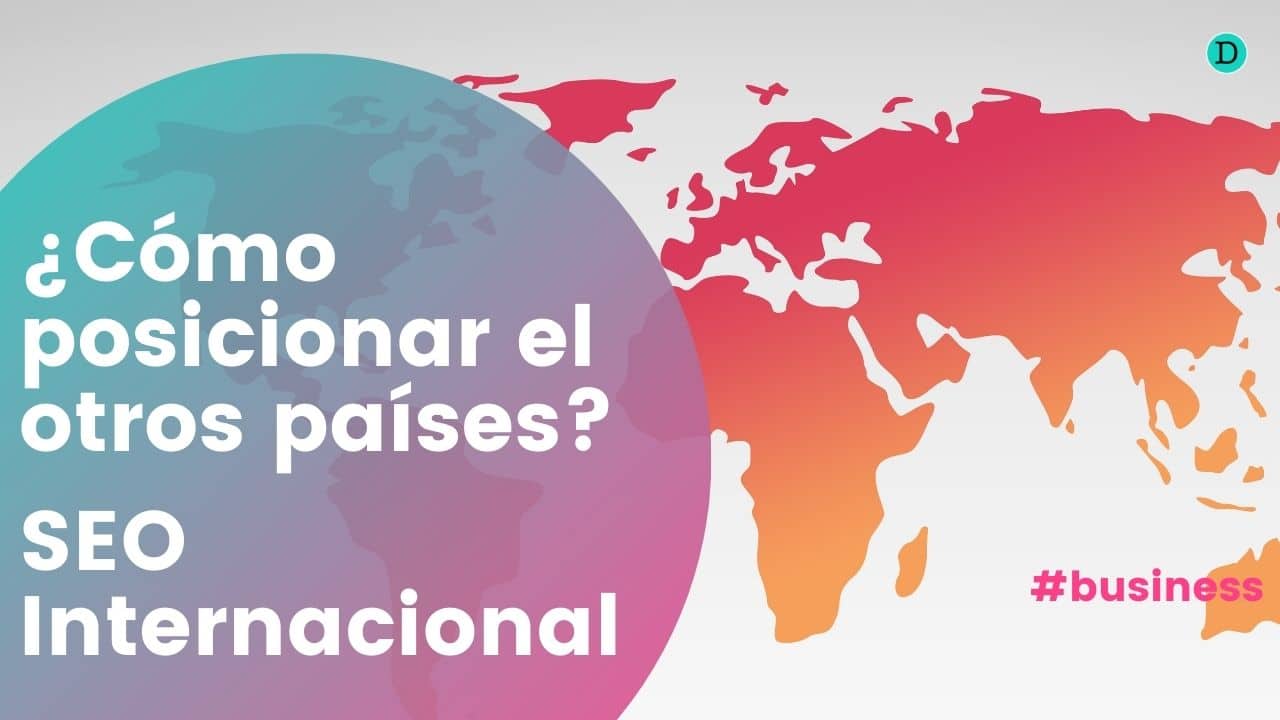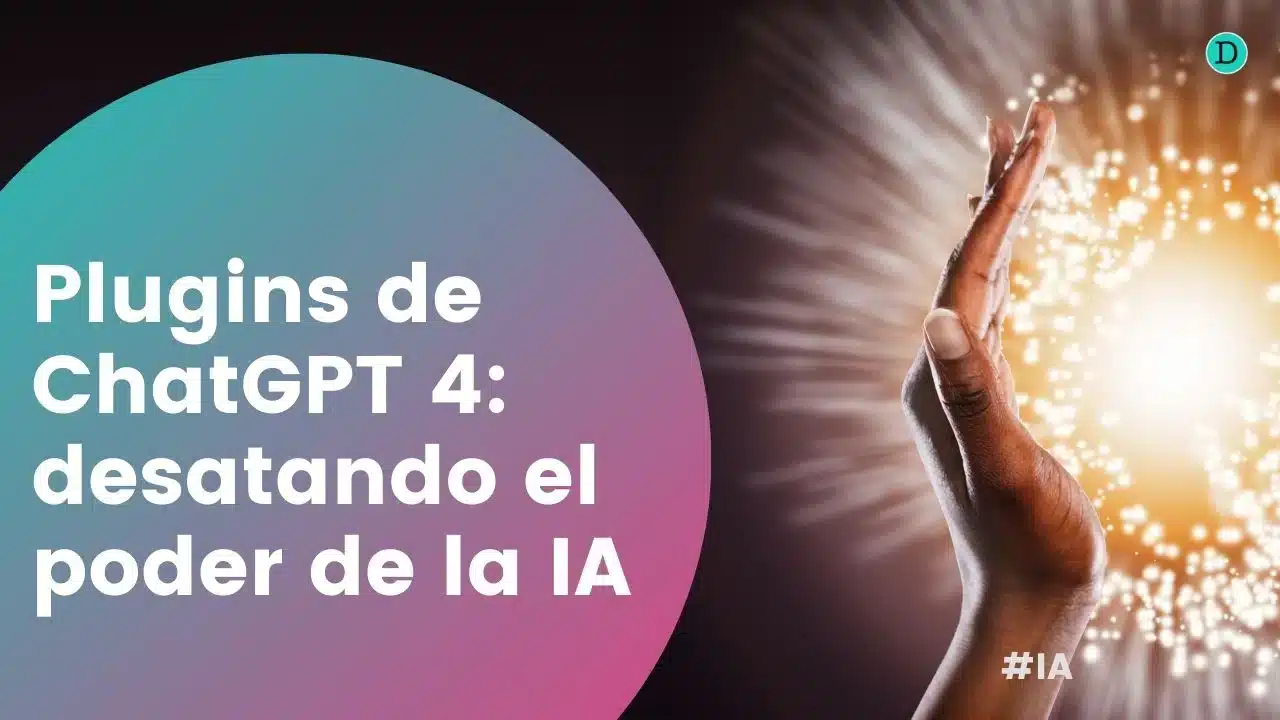ASO, an acronym for App Store Optimisationis one of those acronyms that we are starting to see everywhere. If you are still not up to date, in this article I am going to explain what it is and, by the way, how to do ASO effectively.
The first thing I have to do is to translate. ASO means in-store optimisation of mobile applications. By shop we mean, obviously, online shop. And, also obviously, we are referring to Google Play and App Store.
The ASO is key, together with paid advertising, in the achievement of downloads of our mobile applications. It is also a discipline that is not widely followed, so with a little work we can achieve remarkable results.
In this article we will go over what is the ASOas well as we can do in both Google Play and App Store. To help you do this, we will also mention different tools that can help us find keywords and achieve the best possible optimisation.
What is SWA?

We can say that the ASO is the SEO of mobile applications. If through SEO we aim to appear in the first place when a search is carried out in a search engine, with ASO it is about stand out in search results in mobile app shops.
In other words, when people search for an application with a function like the one our application has, we will be the first to be found.
However, the way to do this is different because there are less room for manoeuvre. In one SEO content strategy is worked along the entire conversion funnel with different pages and content.
In the ASO we can only work on the download page. Thus, the options are more limited, and that is why many people prefer to work alone on their own. SEO or SEM to lead you to that page, without optimising it.
According to a Google study in the United States, 82% of users discover new applications through recommendations from the app shop or by searching directly in the app store. This applies to Google Playbut it is quite likely that the percentages will be similar in the App Store.
Specifically, 48% found them while browsing and 34% found them through app shop recommendations. These high percentages invite us to:
1. Work the page so that it is easy to find and the user will want to download it.
2. Optimise it so that the app shop will want to recommend it.
In this way we will optimise the possibilities for downloading and use by the user.
This is not to say that, in parallel, there is no need to work on SEO and campaigning to bring more users from browsing to browsing.which, of course, it does.
How to do ASO?

Now that we know what the App Store Optimization, Now it's time to get down to work. Although most of the elements are similar in the two shops, there are others that are different, so we will look at them separately.
It is also worth considering that there are other app shops on the web, even if we don't talk about them. For example, there are Amazon Appstore, Samsung Galaxy Store, Uptodown, Xioami Market o Huawei AppGallery.
As a general rule, the number of users of these other app shops is residual and if we have general applications it is usually not worth spending time on them. It only makes sense if we have a specific application for that company.
One of the key points when it comes to making ASO is that we cannot make changes continuously. We can only make such changes when uploading the application. In order to optimise an existing application, it would have to be uploaded again as a new version.
It is therefore very important to ASO from the beginning. It's true that applications need to be updated periodically, so we always have a next opportunity, but if we do it from the beginning, so much the better.'
Let's review the elements we have available to us for optimising in the app shops.
Title
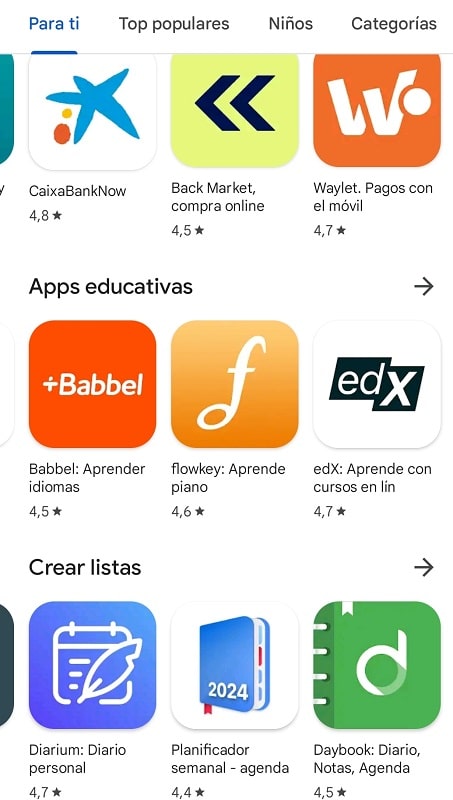
The title is the most important element. This is where the application nameWe can also take the opportunity to add some information regarding the function of the same that will allow us to improve the searches.
Here it is necessary to add the main keyword about what the application does, as we can see in the image above. It should also be noted that there is a character limitation, as we can see in the case of Edx. They wanted to put "Learn with online courses" and it has remained "Learn with online courses". To have it optimised, we could use options such as "Online courses" or "Online learning", for example, depending on our keyword research.
In the rest of the cases, we can see how it is very descriptive and allows users to know what it is about in each case. With Babbel "learn languages", with fowkey "learn piano", "daybook" is a diary, notes and agenda, etc.
The user doesn't need to enter the page to understand the app, he has got it with one word. This screenshot is the main Google Play page, but if the user were to enter "learn languages", "diary", "learn piano", or whatever, these apps would be highlighted as they have the keyword in the title.
Subtitle or short description
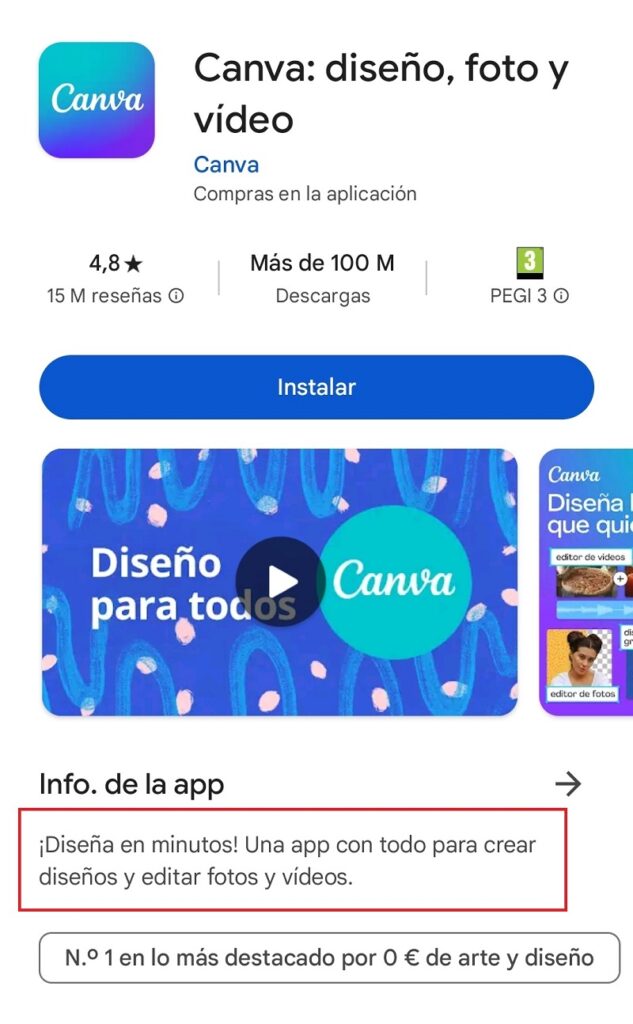
To see the subtitle (App Store) or the short description (Google Play), click on the application and enter the page. In the image, we see the option of App infowhich will lead to what we will later call "Long Description" (only available on Google Play).
This short sentence also corresponds to the App Store subtitle and it must be a short sentence that perfectly explains what the app is aboutwith keywords included. In the example, we see how Canva defines itself as "design, photo and video" in the title and in the subtitle it expands the information by saying: "Design in minutes! An app with everything you need to create designs and edit photos and videos".
In this way, we add some information to the title and we make sure the user has everything they need to decide whether to download or not.
Keywords (App Store)

Keywords only work in the App Store from Apple and are keywords that we can select to help in the search. Just as when working on keywords for SEO, we should use both short and concise keywords as well as long tail keywords.
It is a a very important positioning factor for AppleTherefore, they must be chosen carefully and taking into account those used by the competition. However, there is a problem and that is that these keywords are not visible in the product sheets, so we cannot have direct access to them.
To learn more, Apple has a great guide to keyword work on the App Store.
Long description (Google Play)
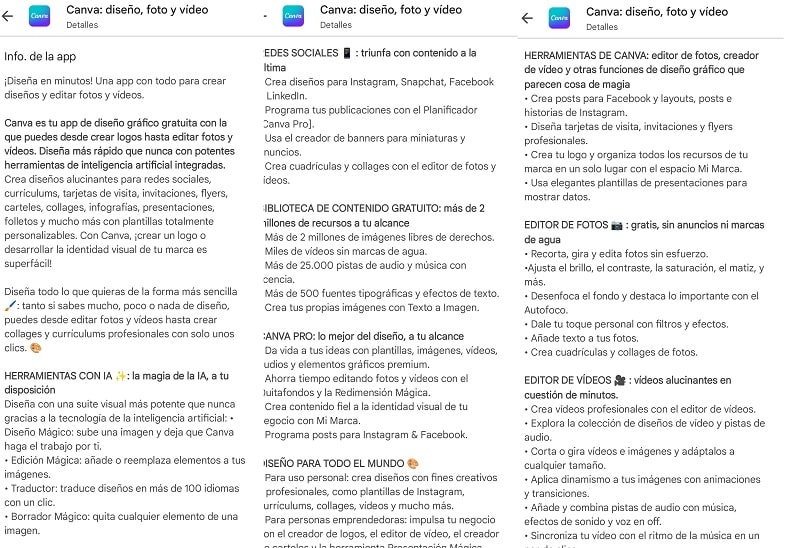
At Google Play there is the short description (equivalent to a subtitle) and the long description which opens in a new page and allows for a very long extension. This is the place where you can work more extensively on ASO.
The best thing to do is to do something like an article in which we break down all the functions available in the mobile application.
Its value as a positioning factor is not as important as the other elements, but it can help us to stand out from the competition. Here we don't need to be so concise, but we can be much more detailed.
Number of downloads and installations
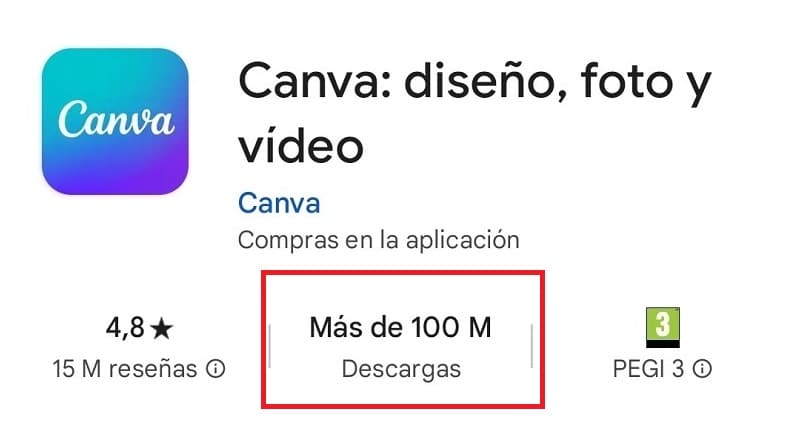
There is little to explain here. The number of downloads and installations is a very important factor for positioning our application. It's simple, the more people download, install and use it regularly (including downloading its updates), the higher an application will be ranked.
At the end of the day, if we and our competitors do a good job ASOwill be the number of downloads and the quality of reviews which will make one or the other stand out. This is very important because a single search position can make a difference of thousands of downloads.
Reviews

The reviews o reviews are another key factor in the positioning in app shops. Just as with the previous point, the better our grades, the higher we will be.
It also helps to position, as in the Google Local Business tabrespond to the reviews.
Of course, the number of reviews is also very relevant, as is the ratio of reviews to the total number of downloads. In this sense, misrepresenting the data and buying positive reviews can be detrimental.
The secret to ranking well at the top is combining a good review score with a high number of downloads and installations. Logical, isn't it?
Updates
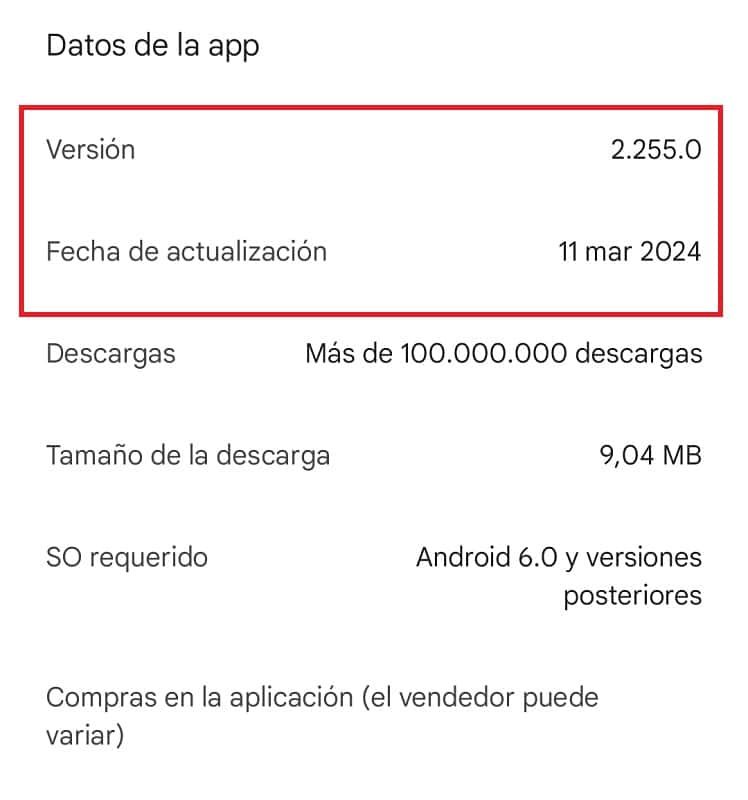
The application updates (with the corresponding detailed update of the improvement) is another positioning point. If your application has been completely unchanged for a long time, it will start to lose positions because it will be understood that it is not up to date.
If we update on a regular basis and explain the changes involved, Google and Apple You will understand that we are keeping up with the times and striving to ensure that our application continues to provide the best service, as technology continues to advance.
In the end it's the same with the content, even with the SEO evergreenIf we never update it, it will eventually lose its relevance and drop a few positions.
Titles, descriptions and images within the application
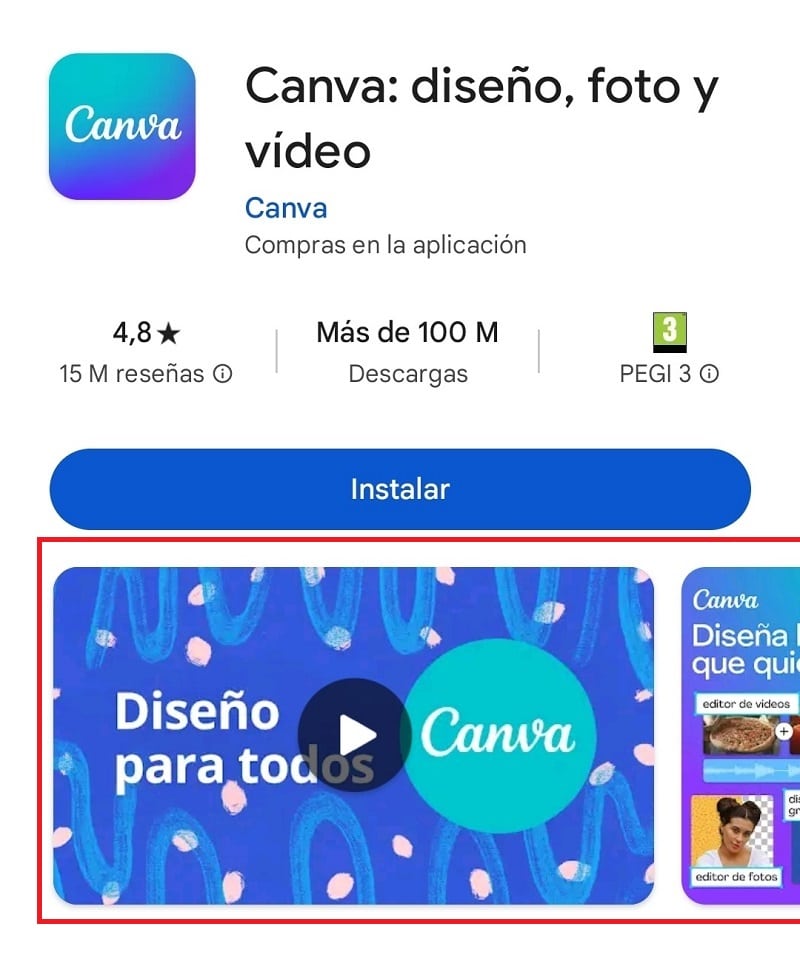
Another last point that helps positioning is the photos, videos and infographics that are added so that the user can see what the application looks like inside and how it works.
There are a few details to bear in mind, depending on whether you are Google Play or the App Store.
On Google Play you can have up to 8 visual elements, including a video of maximum 30 seconds. The video must be hosted on YouTube and have ads and monetisation disabled (it is placed via its URL).
In addition, they will pay particular attention to device-specific screen sizes and realistic representation of the app.
In the Apple App Store you can add two more items, up to a total of 10. Of these, three can be videos, between 15 and 30 seconds. However, a single video is usually recommended (it can be the same one from Google Play but we cannot upload it from YouTube).
Of course, the video must only be of content from inside the app, we cannot place an advert. Covering all ten visual elements is mandatory and we must have the correct sizes for each device.
In addition, text overlays can be used.
Tools for ASO

Of course, the ASO you do in the app shops must be backed up in data. For this, we have two options.
The most common is to use SEO tools as SEmrush, Sistrix o Ahrefs. For example, in SEMrush we have Mobile App Insightsalthough this is a separate subscription. With the tool we can track the position of our keywords in the app shops.
However, if we want to ASO tools We also have specific options. For example, we have AppBot (analysis of reviews), App Intelligent (the most comprehensive) or Keyword Tool (to find keywords).
The problem is that many of these tools involve a large financial outlayso if we only have one application it may not make much sense and it may be better to hire an agency specialised in ASO like ours to manage the positioning and analyse the data.

